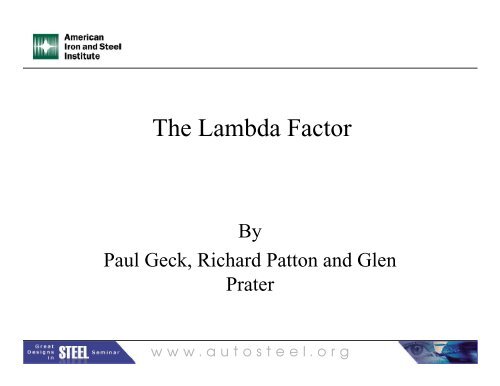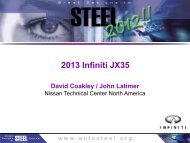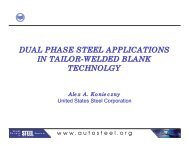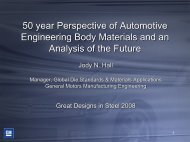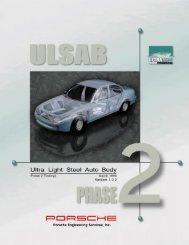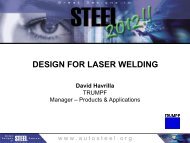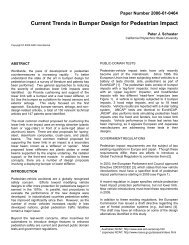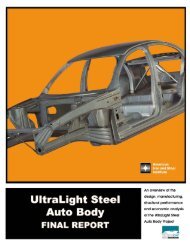You also want an ePaper? Increase the reach of your titles
YUMPU automatically turns print PDFs into web optimized ePapers that Google loves.
<strong>The</strong> <strong>Lambda</strong> <strong>Factor</strong><br />
By<br />
Paul Geck, Richard Patton and Glen<br />
Prater<br />
w w w . a u t o s t e e l . o r g
• <strong>The</strong> lambda factor methodology was<br />
developed as a unified theory for<br />
calculating the weight benefits of<br />
converting from one material to another<br />
(e.g. converting from steel to aluminum).<br />
w w w . a u t o s t e e l . o r g<br />
Overview
• Concept<br />
• Geometric Effects<br />
• Curved Beam Effects<br />
• Joints<br />
– Analysis<br />
–Results<br />
– Improvement<br />
• Generalization of the <strong>The</strong>ory<br />
• Next Steps<br />
w w w . a u t o s t e e l . o r g<br />
Outline
<strong>The</strong>ory – <strong>The</strong> <strong>Lambda</strong> Concept and Material<br />
Selection<br />
• In general, a mechanical response function (e.g.,<br />
stiffness) can be approximated (or for simple<br />
shapes – exactly) by a coefficient times thickness<br />
to some power (C*t λ )<br />
• <strong>The</strong> magnitude of λ is a function of the<br />
architecture being studied and the specific<br />
response being solved for.<br />
• Generally speaking, the response to an increase in<br />
metal thickness is the most important criterion for<br />
weight savings via material substitution<br />
– A linear response favors steel<br />
– A non-linear response favors aluminum<br />
w w w . a u t o s t e e l . o r g
• Flat plate has bending<br />
stiffness dependent on<br />
inertia<br />
• I=1/12*b*t 3<br />
• λ = 3<br />
• Thin-walled tube has<br />
torsional stiffness<br />
dependent on polar<br />
moment of inertia<br />
• J~2*π*r 3 *t 1<br />
• λ = 1<br />
Stiffness of a Flat Plate vs. a Tube<br />
w w w . a u t o s t e e l . o r g
• A flat plate can be<br />
considered as the<br />
extreme of a<br />
continuum of forms<br />
• A tall beam in bending<br />
is more efficient than a<br />
flattened out beam.<br />
w w w . a u t o s t e e l . o r g<br />
Beams in bending
Beam Geometric Non-linearities<br />
• Beam stiffness does not necessarily vary linearly<br />
with metal thickness<br />
• <strong>The</strong>se non-linearities favor aluminum over steel<br />
• In the following plots, 2*t/h is the abscissa, where<br />
– t is the material thickness<br />
– h is the height between the top and bottom flanges<br />
• h = 0 for a flat plate<br />
• h = overall height – 2*t for all other forms<br />
• <strong>The</strong> ordinate is the beam thickness exponent - λ<br />
w w w . a u t o s t e e l . o r g
Beam thickness exponent, λ<br />
3<br />
2.8<br />
2.6<br />
2.4<br />
2.2<br />
2<br />
1.8<br />
1.6<br />
1.4<br />
1.2<br />
1<br />
10 -2<br />
Hollow Beam<br />
Mid-rails<br />
10 -1<br />
Transition<br />
Roughened<br />
sheet<br />
Corrugations<br />
10 0<br />
2*t/h (steel)<br />
Flat Plate<br />
10 1<br />
w w w . a u t o s t e e l . o r g<br />
Beam thickness exponent, λ<br />
10 2
w w w . a u t o s t e e l . o r g<br />
Beam thickness exponent, λ<br />
• Determines weight saved by going to<br />
aluminum from steel<br />
•Formula is:<br />
–m ratio = (ρ al /ρ steel )*(E steel /E al ) 1/λ<br />
– % Weight saved = (1 – m ratio )*100
% Weight Saved<br />
60<br />
50<br />
40<br />
30<br />
20<br />
10<br />
0<br />
-10<br />
10 -2<br />
Aluminum vs. Steel Weight Savings: Geometric<br />
Beam Effects<br />
Hollow Beam Transition Flat Plate<br />
< 8% saved 8% < saved < 46% 46% < saved < 51%<br />
10 -1<br />
10 0<br />
2*t/h (steel)<br />
10 1<br />
w w w . a u t o s t e e l . o r g<br />
10 2
Summary of λ and Beam Geometric Effects<br />
• λ can be used to categorize different structures<br />
• Different beam geometries result in different λs<br />
• Generally speaking, the more efficient the<br />
structure, the lower λ will be<br />
• λ can be computed using finite elements, by<br />
making 2 runs, identical except for changing the<br />
thickness of the elements, from the formula:<br />
– Response = C*t λ<br />
– In these runs, the material should be kept the same<br />
w w w . a u t o s t e e l . o r g
• Thin walled curved beams can also be<br />
treated using λ<br />
w w w . a u t o s t e e l . o r g<br />
Curved Beam Effects<br />
• This includes all joints in the vehicle, as<br />
well as curved beams<br />
• A T-joint can be considered a double curved<br />
beam with two inside flanges
1mm<br />
thickness<br />
λ = 1.3<br />
6.25mm<br />
thickness<br />
λ = 1.1<br />
w w w . a u t o s t e e l . o r g<br />
Curved Beam Bending-Results<br />
From these results, we<br />
know that the stresses<br />
along the inside flange<br />
layer distribute more<br />
evenly when the<br />
thickness becomes<br />
larger.
• Example: A-pillar to roof<br />
• Two loads are applied<br />
– up/down<br />
– In/out<br />
• Rest of joint is grounded<br />
as shown<br />
• Displacements are found<br />
and stiffness calculated<br />
w w w . a u t o s t e e l . o r g<br />
Joint Modeling
• Equations:<br />
• θ = (δ 1 - δ 2 )/D<br />
• M = δ 1 /θ<br />
• K = F*M/θ<br />
w w w . a u t o s t e e l . o r g<br />
Stiffness Calculation
Joint<br />
B/Roof<br />
B/Rocker<br />
Hinge/<br />
Rocker<br />
Load<br />
F/A<br />
I/O<br />
F/A<br />
I/O<br />
F/A<br />
I/O<br />
1.39<br />
1.54<br />
1.33<br />
1.46<br />
w w w . a u t o s t e e l . o r g<br />
λ<br />
1.58<br />
2.00<br />
Joint Analysis Results<br />
% Weight<br />
Saved<br />
32%<br />
41%<br />
25%<br />
30%<br />
22%<br />
28%
w w w . a u t o s t e e l . o r g<br />
Changing <strong>Lambda</strong> - Joints<br />
• <strong>Lambda</strong> can be changed through joint<br />
reinforcement<br />
• <strong>The</strong> reinforcement reduces the stress-relieving<br />
displacement which occurs in curved beams<br />
• As a result, the metal carries the stresses properly,<br />
which increases the stiffness and reduces the stress<br />
• Because the flange metal is carrying stress, λ is<br />
reduced, which in turn reduces the weight-saving<br />
potential value of going to alternate materials
w w w . a u t o s t e e l . o r g<br />
B-Pillar to Rocker –<br />
Original and Reinforced
Inboard-outboard<br />
loading<br />
Original Model<br />
Model with<br />
Reinforcement<br />
Fore-aft loading<br />
Original Model<br />
Model with<br />
Reinforcement<br />
Reinforcement Results<br />
1.5474<br />
1.1517<br />
w w w . a u t o s t e e l . o r g<br />
λ<br />
λ<br />
1.3893<br />
1.144
w w w . a u t o s t e e l . o r g<br />
Joint Analysis - Conclusions<br />
• <strong>The</strong> response of a structure to changes in wall<br />
thickness can be used to predict the weight savings<br />
from material substitution<br />
• λ is a very good predictor of weight savings for<br />
equivalent stiffness<br />
• Average λ = 1.51<br />
– Average weight savings of 30% in joints for steel to<br />
aluminum material substitution<br />
• Variations in geometry between joints cause the<br />
changes in λ for the different joints<br />
• λ for a joint can be changed through redesign and<br />
reinforcement
• Gauge sensitivity can be assessed for individual components, cross sections, or full vehicle<br />
body structures.<br />
• <strong>The</strong> parameter is very well suited for evaluating the weight changes associated with<br />
material, architecture, and/or gauge changes.<br />
• For the negligible-web beam, l ranges between 1.0 (uniform internal load distributions,<br />
very efficient structure) to 3.0. (non-uniform internal load distribution, less efficient<br />
structure).<br />
• Other effects that have effect of increasing λ include torsional loads, shear lag, elastic<br />
instability associated with compressive buckling.<br />
• For structures with low λ values, the mass savings generated by a constant-stiffness<br />
material substitution is proportional to the ratio of specific elastic moduli:<br />
Δ<br />
m<br />
⎡ E1<br />
/ ρ<br />
= 100⎢1−<br />
⎣ E2<br />
/ ρ<br />
1<br />
2<br />
⎤<br />
⎥<br />
⎦<br />
Generalization of the <strong>The</strong>ory<br />
w w w . a u t o s t e e l . o r g
Future Work - Global Gauge<br />
Sensitivity Indices<br />
• Investigate the possibility of defining a global λ based upon forced dynamic response,<br />
including compliance frequency response, and crash.<br />
• Develop the analytical background (calculation methodology, weight savings<br />
predictions) for a global λ based upon a variety of body stiffness metrics (e.g., closure<br />
distortions).<br />
• Use CARS/GAS and other tools to continue to investigate the influence of thin-wall<br />
effects on λ behavior and interpretation.<br />
• Conduct comparative global gauge sensitivity studies for a variety of passenger car and<br />
truck bodies.<br />
• Determine the nature and magnitude of the errors induced by the assumption that<br />
responses are exactly proportional to a constant times “t” to the “λ”(C*t λ ).<br />
• Continue to investigate the use of global λ curves to assess the effectiveness of local<br />
architecture changes.<br />
w w w . a u t o s t e e l . o r g


